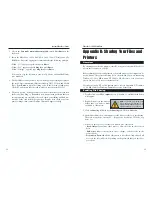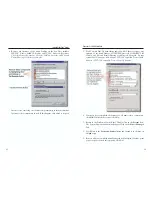
Instant EtherFast
®
Series
Appendix H: Uninstalling the Drivers
with the Install Wizard
1. Insert the Setup Utility CD into your CD-ROM drive. The Install Wizard’s
Welcome screen will come up automatically and identify the version of
Windows you are using.
2. Move your cursor
over the
Uninstall
tab and the
Uninstall screen
will appear. Click
the
Uninstall
but-
ton.
3. The drivers will be uninstalled auto-
matically. When this process is com-
plete, you will see the following
screen.
Driver uninstall complete!
EtherFast
®
10/100 LAN Card
Appendix I: Glossary
10BaseT
- An Ethernet standard that uses twisted wire pairs.
100BaseTX
- IEEE physical layer specification for 100 Mbps over two pairs of
Category 5 UTP or STP wire.
Architecture
- The total design and implementation of the network. It includes
the network's topology, transmission technologies and communications proto-
cols, management and security systems, and any other attributes that give a net-
work a particular set of capabilities and functionalities.
Backbone
- The part of a network that connects most of the systems and net-
works together and handles the most data.
Bandwidth
- The transmission capacity of a given facility, in terms of how
much data the facility can transmit in a fixed amount of time; expressed in bits
per second (bps).
Bit
- A binary digit. The value - 0 or 1-used in the binary numbering system.
Also, the smallest form of data.
Boot
- To cause the computer to start executing instructions. Personal comput-
ers contain built-in instructions in a ROM chip that are automatically executed
on startup. These instructions search for the operating system, load it and pass
control to it.
Browser
- A browser is an application program that provides a way to look at
and interact with all the information on the World Wide Web or PC. The word
"browser" seems to have originated prior to the Web as a generic term for user
interfaces that let you browse text files online.
Bus Mastering
- A bus design that allows the peripheral controllers (plug-in
boards) to access the computer's memory independently of the CPU. It allows
data transfers to take place between the peripheral device and memory while
the CPU is performing other tasks.
Cable Modem
- A device that connects a computer to the cable television net-
work, which in turn connects to the Internet. Once connected, cable modem
users have a continuous connection to the Internet. Cable modems feature
76
75





















